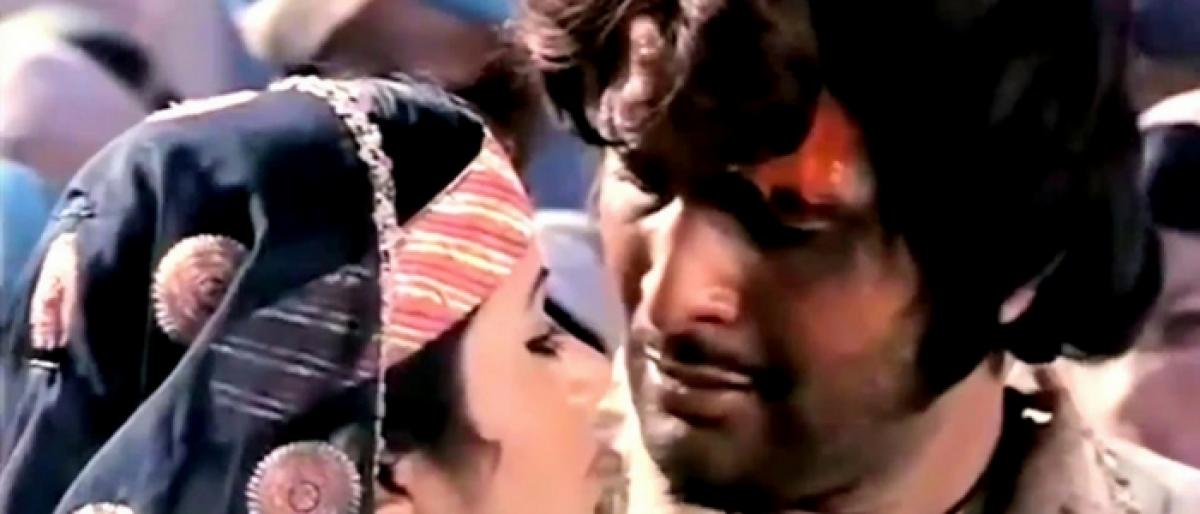Live
- K.T. Rama Rao calls on farmers arrested for attack on Vikarabad officials
- AP CM Chandrababu Naidu Unveils Vision for Andhra Pradesh amidst Financial Challenges
- VVS Laxman lauds fans for massive support on foreign tours
- Bengal lottery scam: Huge amount of cash traced, ED brings currency counting machine
- Raj Thackeray releases MNS election Manifesto with a ‘key’ to implementing it
- Gold prices likely to further come down with no near-term positive triggers
- Tough decision, but it's the right one: Southee on Test retirement
- After caste census, Dalits, tribals, poor will recognise their true strength: Rahul Gandhi
- Who was Birsa Munda, whose 'Ulgulan' declared the end of British rule in Jharkhand?
- Logistic firm Delhivery’s profit tanks over 80 pc in April-Sep period
Just In

In any literary tradition, the works of even its less famous or forgotten figures are liable to crop up at some unexpected place. As in Hindi film songs, with which Urdu poetry has been closely linked from the beginning. While their soulful, stirring or soothing lyrics come from the creativity of poets from Sahir Ludhianvi to Gulzar, Majrooh Sultanpuri to Javed Akhtar, sometimes inspiration comes
The surprising origins of some much-hummed Bollywood songs
In any literary tradition, the works of even its less famous or forgotten figures are liable to crop up at some unexpected place. As in Hindi film songs, with which Urdu poetry has been closely linked from the beginning. While their soulful, stirring or soothing lyrics come from the creativity of poets from Sahir Ludhianvi to Gulzar, Majrooh Sultanpuri to Javed Akhtar, sometimes inspiration comes from elsewhere too.
And this has been the case right from the days of KL Saigal. While New Theatres – where he began his career in what was then called Calcutta – could afford to draw on the services of established and original poets like Syed Anwar Hussain “ArzooLakhnavi”, some others found inspiration from long-foregone poets too. Take Pandit Sudarshan, with his rather doleful "Andheki lathi tu hi hai, tu hi jivanujiyaraarahai..." for ‘DhoopChhaon’ (1935).
As Saigal aficionados will recall, it begins with a spoken couplet: "Dil ke phapholejaluthe seene ke daag se/Is gharkoaag lag gayi ghar ke chiraag se" – and while Sudarshan can take credit for the song, these lines were inspired by an 18th century prodigy.
Pandit Mehtab Rai "Taban" was 12 when he recited: "Sholaabhadakutha mere is dilkedaagh se/Aakhirgharkoaag lag gayigharkechiraagh se" at a Delhi mushaira, impressing Khwaja Mir Dard, who was in attendance.
But at this point, it must be clarified that this is not plagiarism, but an accepted part of the Urdu poetic tradition where even one couplet, or even one line, may be used by another poet – as it is or modified appropriately – for another context.
Another major example is from Dilip Kumar-Nargis starrer ‘Mela’ (1948), which was also significant in bringing together a trio responsible for some still-cherished songs – music director Naushad, lyricist Shakeel Badayuni and singer Mohammed Rafi. The film's signature classic "Yehzindagikemele..." was, however, not entirely Shakeel's brainchild.
"Yehzindagikemele, yehzindagikemele, duniyameinkamnahonge/Afsos ham nahonge..." derives inspiration from 18th century Faizabad master poet Mirza Mohammad Taqi 'Taqi", who had declaimed: "Duniyake jo maze haihargizvohkamnahonge/Charcheyahinrahengeafsos ham nahonge..."
The trend continued sporadically. In 1969, Majrooh Sultanpuri borrowed one telling line from Faiz Ahmed Faiz's immortal "Mujh se pehli se mohabbat..." (already used fully in Pakistani film ‘Qaidi’) to make it the opening for Rafi-rendered "Teri aankhon ke siva duniya mein rakha kyahai..." for ‘Chirag’ (1969) starring Sunil Dutt and Asha Parekh.
Gulzar followed suit in ‘Mausam’ (1975), using Ghalib's couplet "Dild hoondhta hai phir wahifursatke raat din/Baitherahe tasavvur-e-jaanankiye hue..." to initiate the song of the name sung soulfully by Bhupinder and Lata Mangeshkar.
Even Sahir couldn't resist. In the Bollywood remake of that tragic Middle Eastern love story, one key sequence – and the resulting song – in ‘Laila-Majnu’ (1976) draws inspiration from an 18th century Sufi saint living near Lucknow who was a self-taught shayar.
Sheikh Turab Ali Qalandar Kakorvi's "Shahrmeinapne Laila ne manadikar di/Koi pathar se namaare mere deewaneko" is better known to us as in the form: "Husn haazir hai mohabbat ki saza paaneko/Koi patthar se namaare mere diwaaneko" as the heroine defies – and simultaneously manages to pacify – a blood thirsty gathering.
In 1981, Anand Bakshi went entirely truthful with the trend by crediting the poet in the song itself. In the tragic inter-regional romance which introduced Kamal Haasan to a pan-Indian audience, the ‘Ek Duje Ke Liye’ title song has the heroine (Rati Agnihotri) say: "Ishq par zornahi, Ghalib ne kaha hai isiliye..." Beat that.
There are not many such examples since then. It is possible that the new breed of lyricists were not that comfortable with, or even conscious of, the Urdu literary tradition – or simply sought to move on with a new idiom and style of speech.
But while the reason cannot be known with any reasonable degree of certitude, here is another example but one that is only peripherally connected to Bollywood.
From the 1970s, Indian whiskey brand Bagpiper has roped in various actors for its advertisements – direct and then surrogate. Remember Shatrughan Sinha and subsequently Dharmendra's invitation: "Khoob jamega rang, jab mil baithenge teen yaar–aap main aur Bagpiper".
This also derives from a sher– of Ghalib's poetic disciple Mian Dad Khan "Sayyah", who had said: "Qais jangal mein akela hai mujhe jaane do/Khub guzregi jo mil baithenge dewane do".
It's two that makes company, not three – unless it is celebrity endorsement.

© 2024 Hyderabad Media House Limited/The Hans India. All rights reserved. Powered by hocalwire.com







